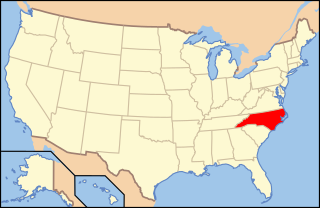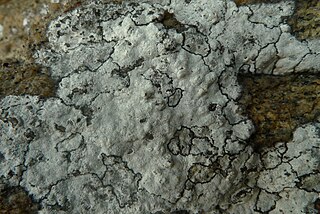
The Gomphillaceae are a family of lichen-forming fungi in the order Graphidales. Species in this family are found mostly in tropical regions.
Aquamarina is a fungal genus in the class Dothideomycetes. It is a monotypic genus, containing the single marine species Aquamarina speciosa, originally found in North Carolina, and distributed in the Atlantic Coast of the United States. The bluish-green species fruits exclusively in the lower parts of dying culms of the saltmarsh plant Juncus roemerianus.

The Trypetheliaceae are a family of mainly lichen-forming fungi in the order Trypetheliales. The family consists almost exclusively of corticolous (bark-dwelling), crustose lichens with an almost strictly tropical distribution.
Polymeridium is a genus of lichen-forming fungi in the family Trypetheliaceae. Species in the genus are corticolous (bark-dwelling) and typically occur in tropical areas.
Keissleriella rara is a rare species of fungus in the family Lophiostomataceae. The species fruits exclusively on dead or dying standing culms of the saltmarsh plant Juncus roemerianus. It is known only from the Atlantic Coast of North Carolina.
Massarina carolinensis is a species of fungus in the Lophiostomataceae family. The species is found exclusively on the lower parts of the culms of the saltmarsh Juncus roemerianus on the Atlantic Coast of North Carolina.

Paraphaeosphaeria pilleata is a species of fungus in the Lophiostomataceae family. The species fruits exclusively in the lower parts of the culms of the black needlerush. It is found on the Atlantic Coast of North Carolina.

Lathagrium is a genus of lichen-forming fungi in the family Collemataceae. It has 10 species of gelatinous lichens. Species in this genus typically grow on calcareous rocks, often amidst mosses, but can also be found on siliceous or serpentine rocks, mortar, or soil.

Roccellographaceae is a family of lichen-forming fungi in the order Arthoniales. It contains three genera: Dimidiographa, Fulvophyton, and Roccellographa.

Rhizocarpales are an order of lichen-forming fungi in the subclass Lecanoromycetidae of the class Lecanoromycetes. It has two families, Rhizocarpaceae and Sporastatiaceae, which contain mostly crustose lichens.

Carbonicola is a small genus of lichen-forming fungi. It is the sole genus in the monogeneric family Carbonicolaceae. The genus, which collectively has an almost cosmopolitan distribution, contains three squamulose lichens that prefer to grow on burned wood in temperate areas of the world.
Dictyomeridium is a genus of corticolous (bark-dwelling), crustose lichens in the family Trypetheliaceae. It has eight species.
Ostropomyces is a genus of fungi in the family Stictidaceae. It has two species, both of which are found in tropical forests in northern Thailand, where they grow as saprotrophs on bark.
Astrothelium chulumanense is a little-known species of corticolous (bark-dwelling), crustose lichen in the family Trypetheliaceae. Found in the Yungas montane forest of Bolivia, it was formally described as a new species in 2023. It is characterized by pseudostromata not differing in colour from the thallus, perithecia immersed for the most part in the thallus with the upper part elevated above and covered with orange pigment, apical and fused ostioles, the absence of lichexanthone, a clear hamathecium, eight-spored asci, and large, muriform ascospores with a thickened median septum.
Polymeridium costaricense is a species of corticolous (bark-dwelling) lichen in the family Trypetheliaceae. Found in Costa Rica and Brazil, it was formally described as a new species in 2013 by Dutch lichenologist André Aptroot. The lichen bears a resemblance to Polymeridium chioneum but is differentiated by its non-fluorescent thallus under ultraviolet light (UV–). The type specimen of P. costaricense was collected in Palo Verde National Park, Guanacaste, Costa Rica, along the trail to Rio Tempisque, growing on tree bark. The type specimen of P. costaricense was initially reported and illustrated as P. chioneum by Aptroot and colleagues in 2008. Additional specimens have been examined from Chapada do Araraipe, Ceará, Brazil.
Polymeridium multiforme is a species of corticolous (bark-dwelling) lichen in the family Trypetheliaceae. It is found in the Neotropics, with specimens recorded from Brazil, Guyana, and Venezuela. The lichen was described by Dutch lichenologist André Aptroot in 2013. This lichen closely resembles Polymeridium quinqueseptatum, but its thallus is whitish-grey and fluoresces yellow under ultraviolet light. Additionally, the hamathecium of P. multiforme is not interspersed with oil droplets. The type specimen was collected in Guyana, at the base of Makarapan Mountain, on the bark of a Myrsinaceae tree.
Astrothelium supraclandestinum is a species of lichen in the family Trypetheliaceae. This lichen species is closely related to Astrothelium subclandestinum, but differs in its hamathecium, which is not inspersed. The species is widespread and has been observed in several countries across different continents.
Pisorisporiales is an order of fungi within the phylum of Ascomycota and in the class Sordariomycetes and subdivision of Pezizomycotina and also its own subclass Pisorisporiomycetidae.
Protothelenella is a genus of fungi in the family Protothelenellaceae. It contains 11 species, some of which form lichens. Protothelenella species have a crustose thallus with spherical to pear-shaped, dark brown to blackish perithecia. Microscopic characteristics of the genus include bitunicate asci with an amyloid tholus, and ascospores that are colourless and contain multiple internal partitions. Some species grow on acidic substrates including rocks, soil, bryophytes, plant detritus or rotten wood. Other species are lichenicolous (lichen-dwelling), growing on species of Solorina, Peltigera, Pseudocyphellaria, or Cladonia.

Polycoccaceae is a family of lichenicolous (lichen-dwelling) fungi in the order Trypetheliales. The family was circumscribed in 2015 by Damien Ertz, Josef Hafellner, and Paul Diederich. Molecular phylogenetic analysis shows Polycoccaceae to have a sister relationship with the family Trypetheliaceae.







